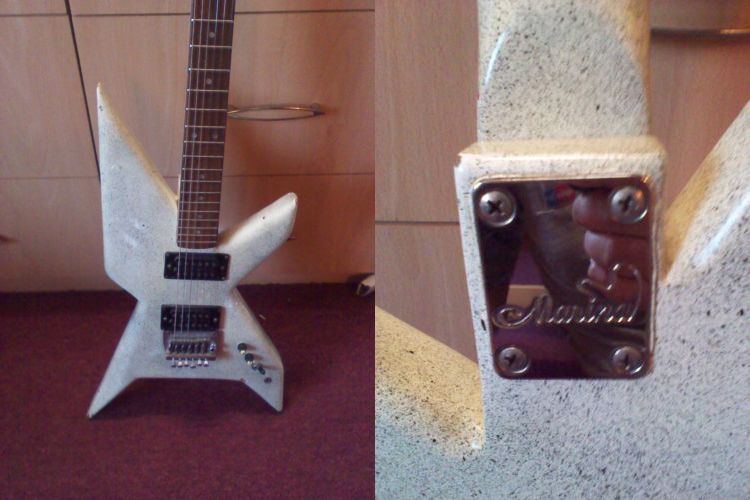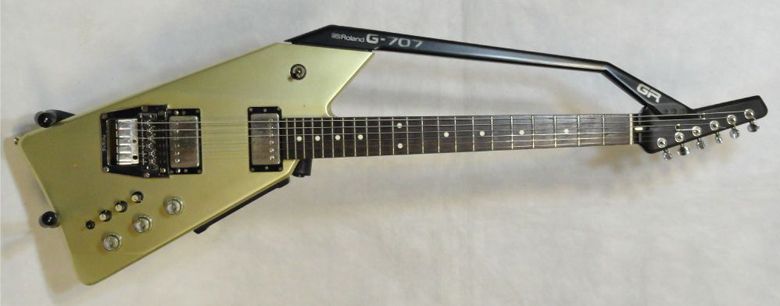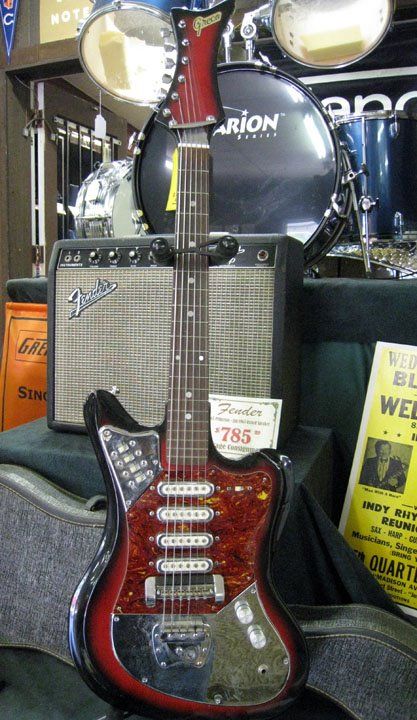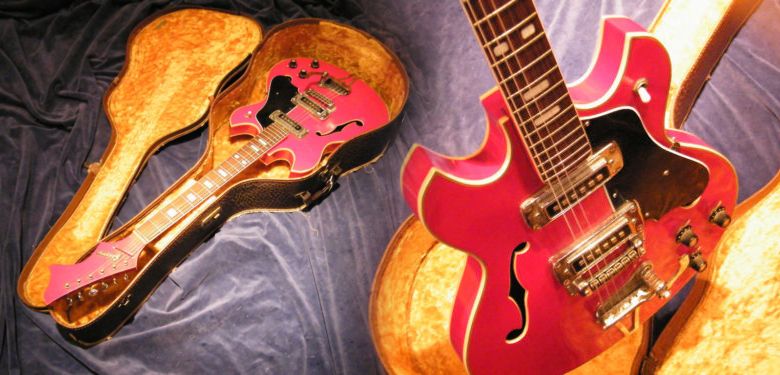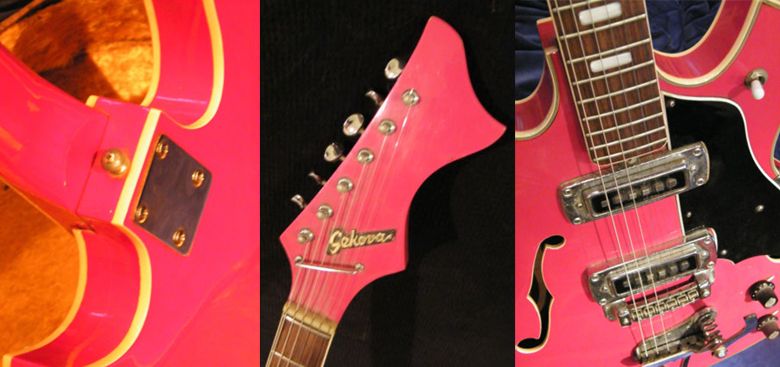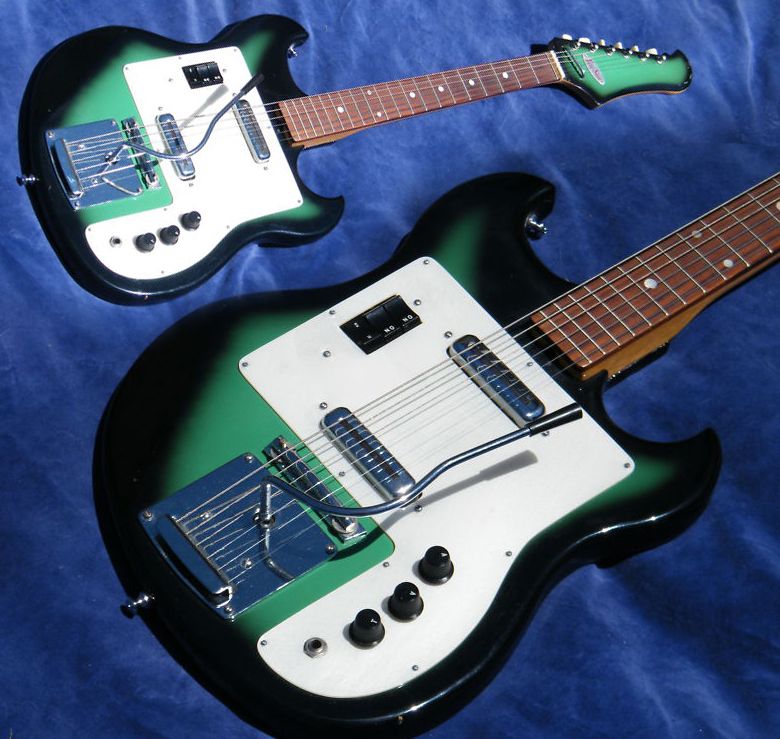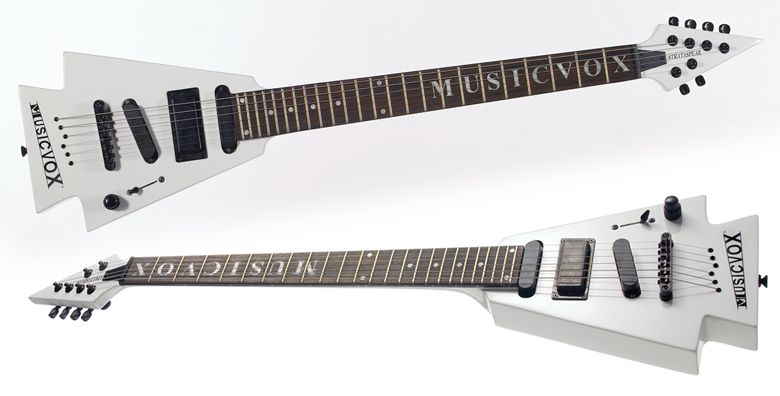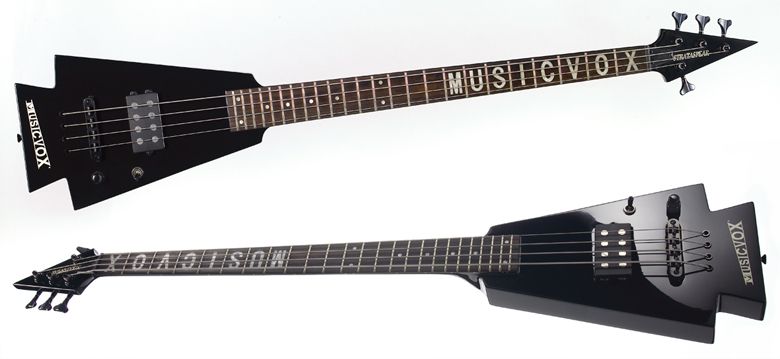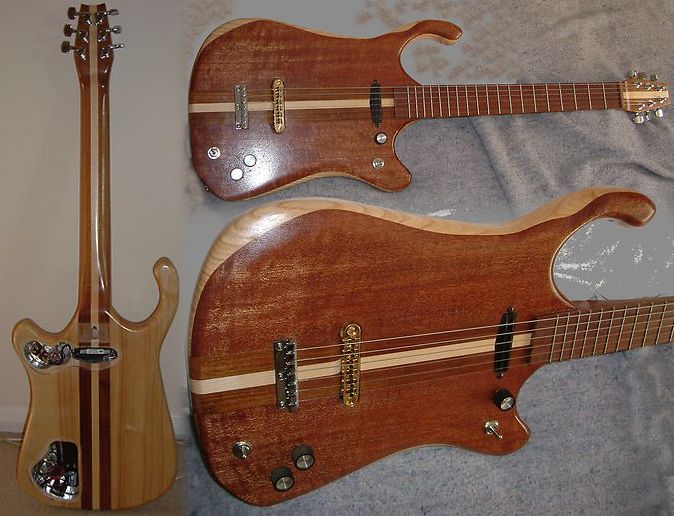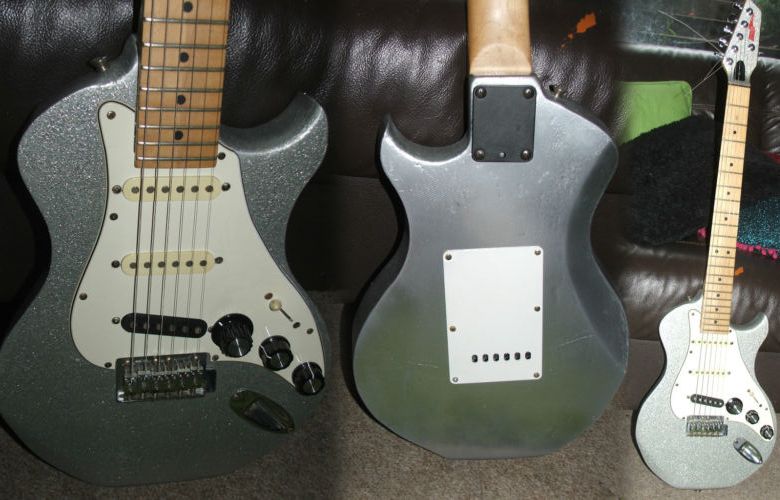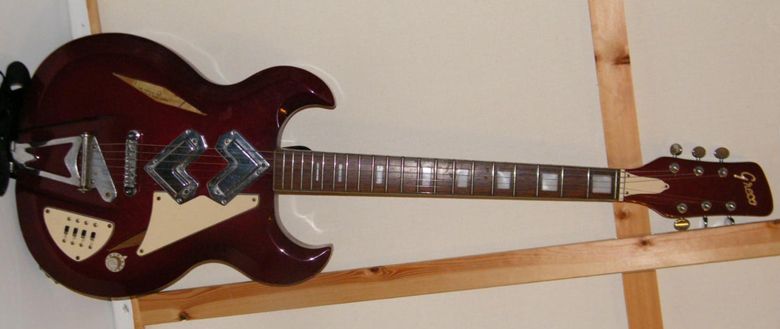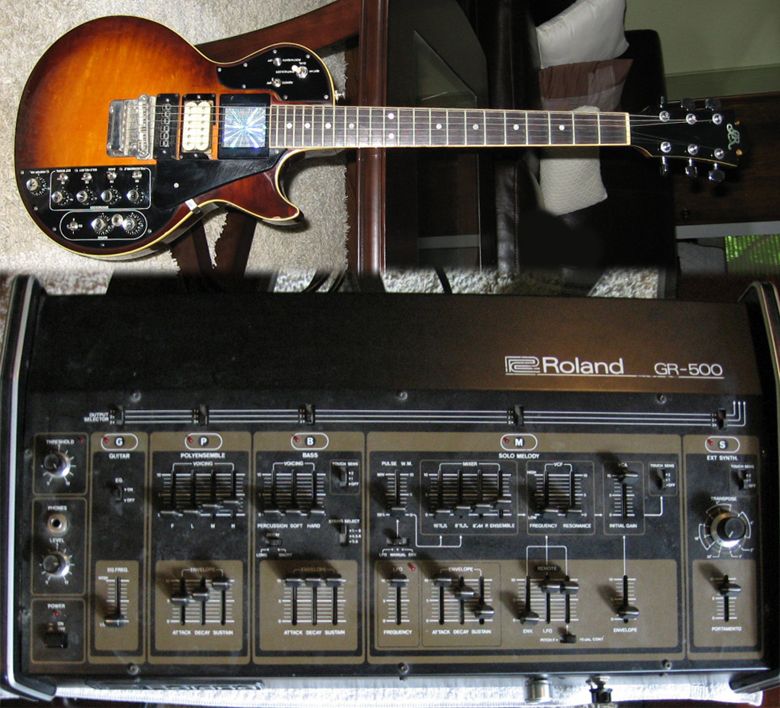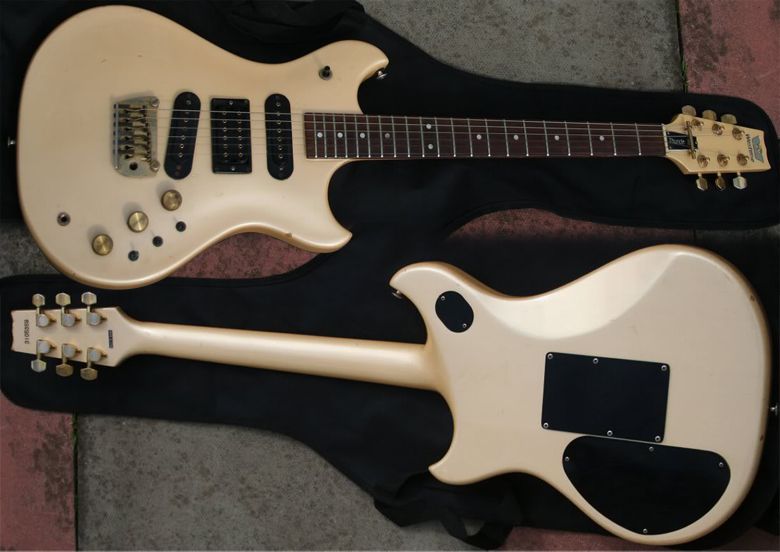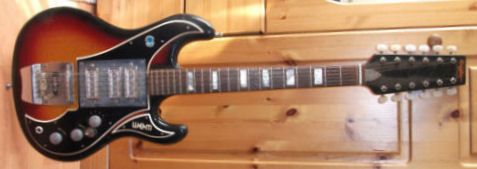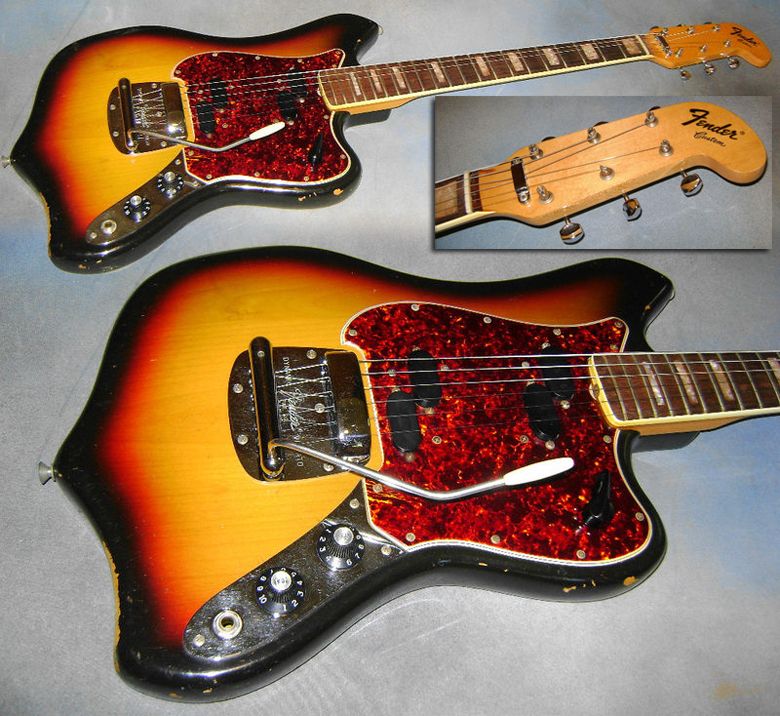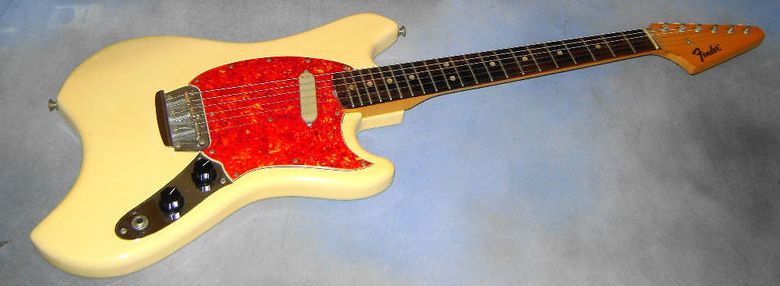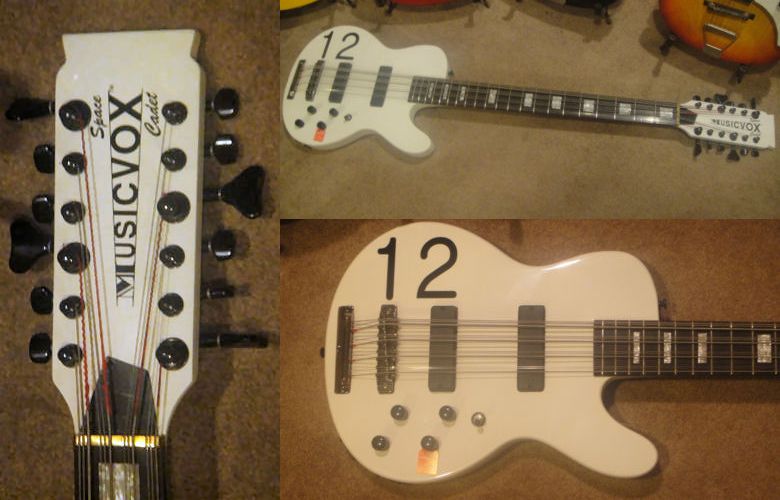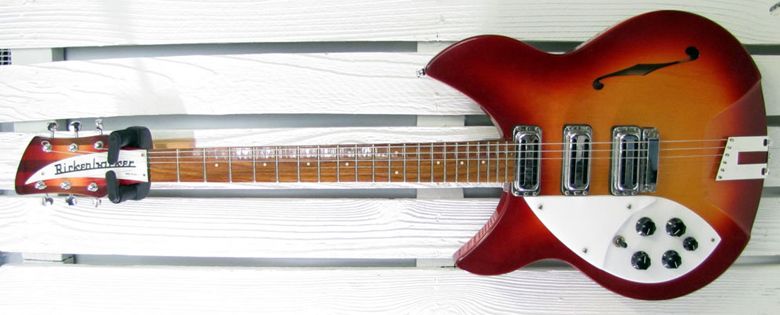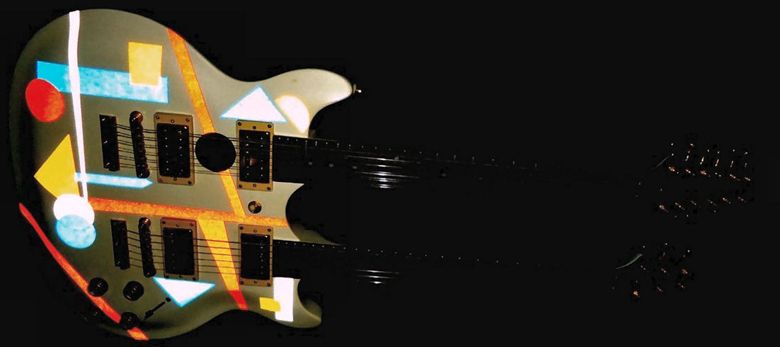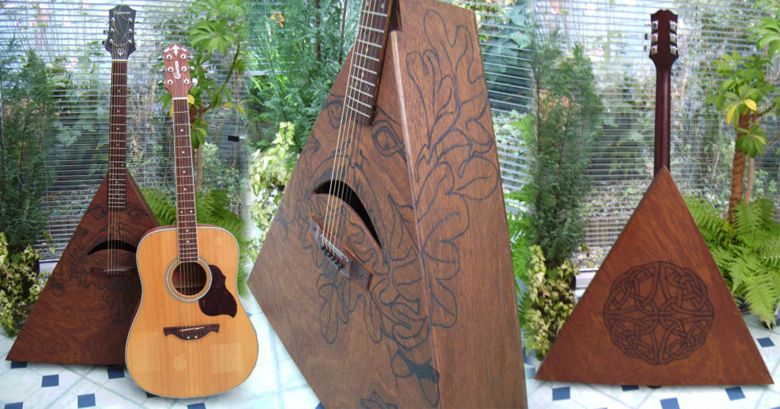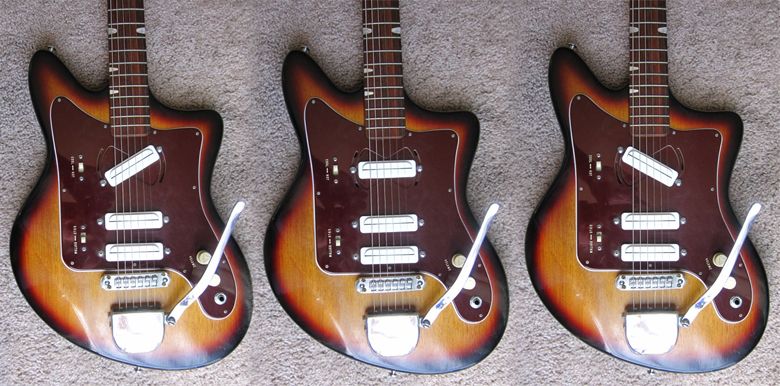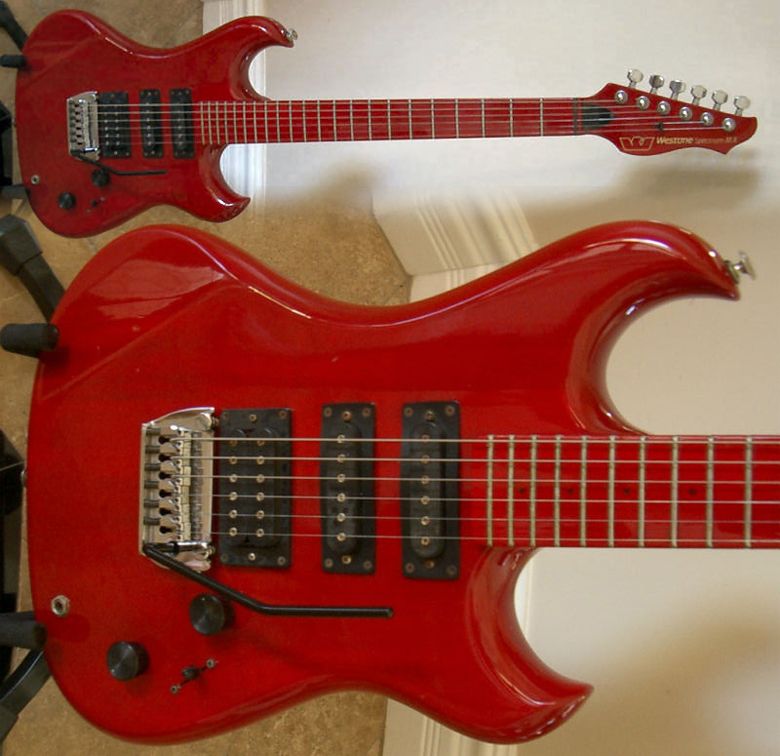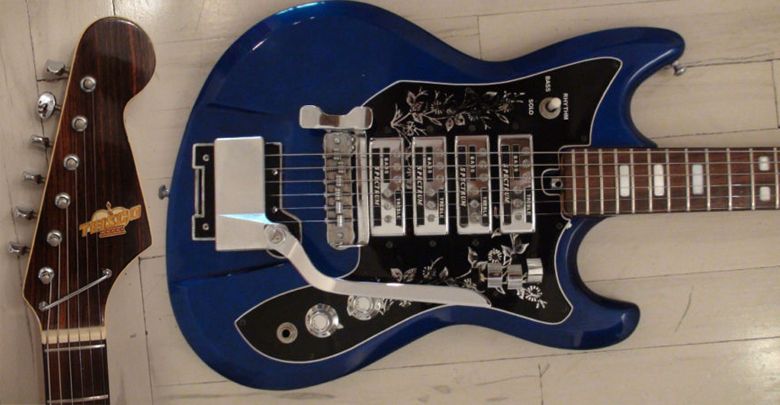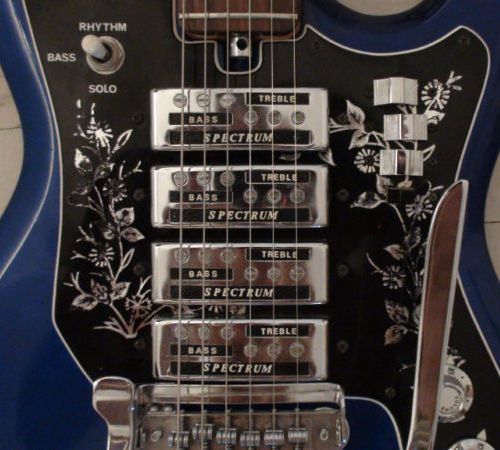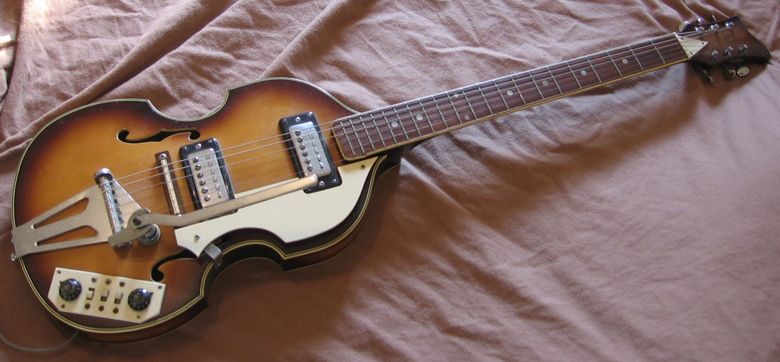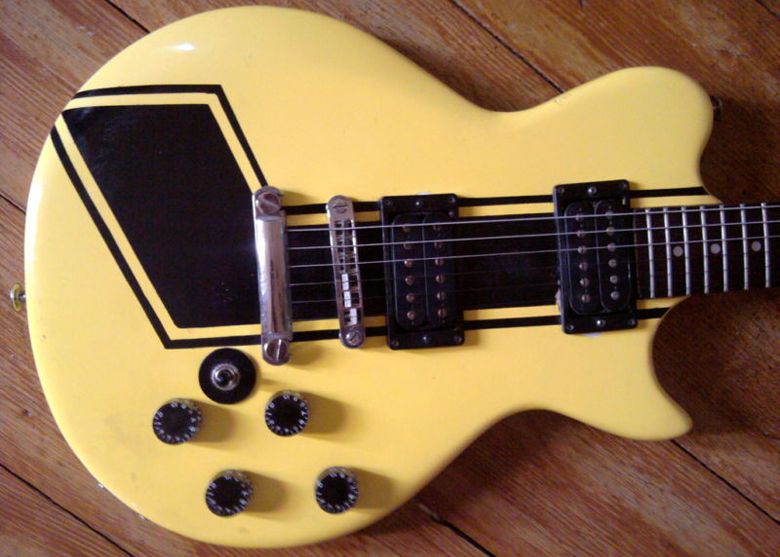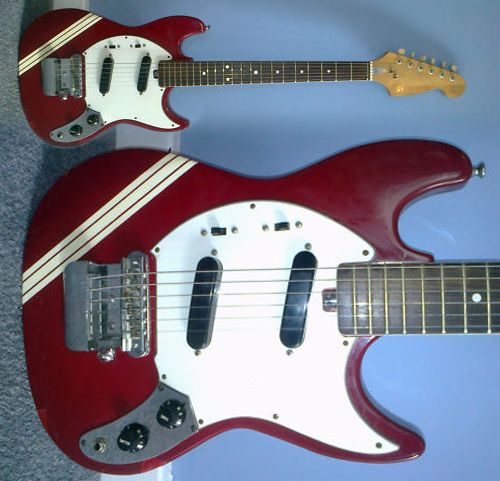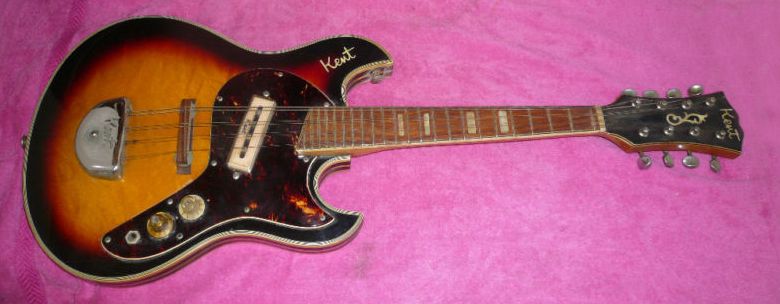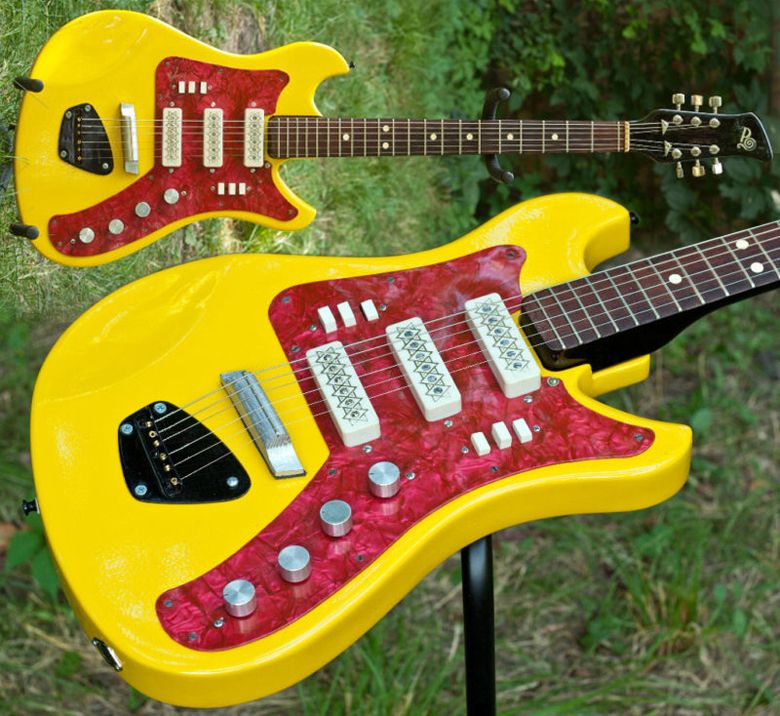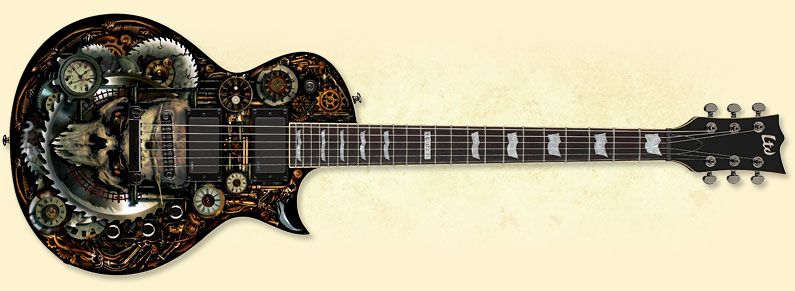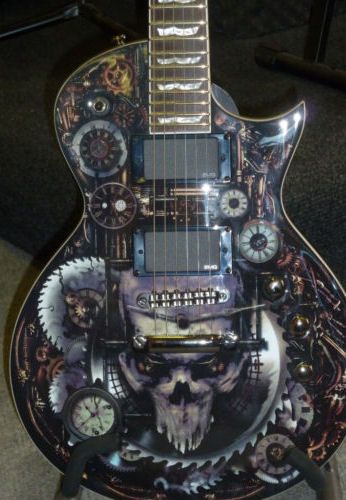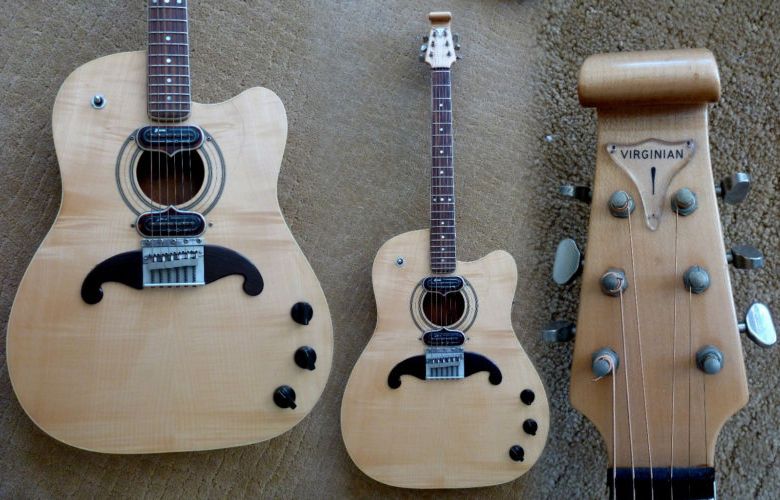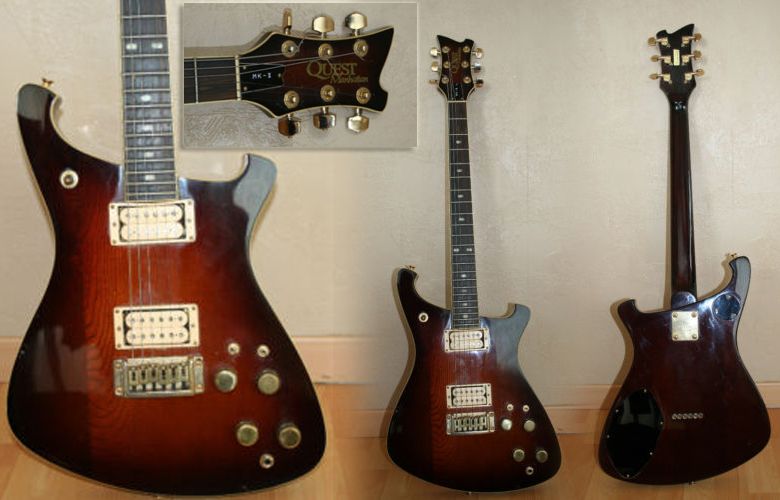Weird pointy Marina guitar, possibly 1980s Japanese
/
But if you know differently...
(Thanks to Lewis who spied this guitar listed on eBay).
G L Wilson
© 2011, Guitarz - The Original Guitar Blog - now in its 10th year!
11:51 AM | Labels: 80s guitars, 90s guitars, pointy guitar, Weird guitars, What's that guitar?
Dalek's Handbag: Roland G-707 Guitar Synth controller from the mid 1980s
/
From Roland's first guitar synth to its last with dedicated guitar controller, the guitar being known as the Roland G-707 and partnered the over-sized stomp box making up the GR-700 synthesiser itself.
To think that these guitars are approaching "vintage" status seems crazy. I remember well when these first came out; we all laughed at the shape and the peculiar "handle connecting" body to headstock (to eliminate deadspots, supposedly, to allow for better tracking); we called it the "Dalek's Handbag".
They were produced from 1984-86. I'm guessing the example pictured above is one of the earlier ones, being finished in silver which over the years has started to turn gold. Later examples were optionally available in red or black finishes.
This example (guitar only - no synth unit) is currently being offered for sale on eBay with a Buy It Now price of $699.99. I don't really see the point of buying the guitar without the synth, not unless you are really into the shape or else you want to buy something for your pet dalek's birthday.
For more information see Vintage Synth Explorer.
G L Wilson
© 2011, Guitarz - The Original Guitar Blog - now in its 10th year!
3:11 AM | Labels: 80s guitars, Guitar Synth, Japanese guitar, Roland, Weird guitars
The Fosse Electric Sitar
/
The above would appear to be a prototype. The production model, looking more akin to a traditional sitar in shape, is shown in this next YouTube clip:
© 2011, Guitarz - The Original Guitar Blog - now in its 10th year!
1960s 4-pickup Greco solidbody "surf" guitar - but does anyone know the model?
/
Amy Osbourne wrote the following on our Facebook page:
Hey all! I own a shop in Indianapolis. I came across your info while researching this Greco that just came in. There is no serial. Would anybody be able to tell me more about it? Anything is helpful! Thanks!Well, it's very similar to a Greco we looked at before but has four pickups rather than two.
Wikipedia tells us that:
...in the mid/late 1960s, Kanda Shokai produced Greco branded guitars based on Hagström and EKO designs for Avnet/Goya in the USA and these guitars were made by the Teisco and FujiGen guitar factories and were very similar to the late 1960s Ibanez guitars based on Hagström and EKO designs.I wonder if they also used Framus guitars as a design influence, for this Greco is very reminiscent of the Framus Strato Deluxe, especially with the large metal plate behind the bridge.
Guitars were so much more interesting back in the 1960s, it seems. You had companies all over Europe producing all manner of weird and wonderful designs, and then you had the Japanese copying them so that with some guitars it's very hard to tell which is the original design and just who copied who.
But if anyone does have any further information about Amy's 4-pickup Greco, please chip in under the comments section below this post.
G L Wilson
© 2011, Guitarz - The Original Guitar Blog - now in its 10th year!
11:21 AM | Labels: cool guitars, Greco, Japanese guitar, vintage guitars, What's that guitar?
Sekova hollowbody electric: another 1960s Japanese-made oddity
/
However, I take one look at these photos of this 1960s Japanese-made Sekova and I can't help imagine it rattling like hell when played and producing a boxy tone.
There's something very odd-looking about its construction. Take a look, for instance, at the way that the neck pocket is biased towards the treble-side of the instrument when it looks as if there was plenty of space to have it centred and achieve a better fit.
I confess that I know nearly nothing about the Sekova brand, so I'm not going to throw random Japanese brand names about (Teisco, Kawai, Guyatone, etc...) hoping that one will stick. However, if I was to make an educated guess, I can't help noticing the similarity of the headstock shape with that of this Greco guitar produced by the Kanda Shokai company (which had guitars built at the FujiGen and Teisco factories).
This may be a "rare" or unusual guitar in this day and age, but once again we see a totally unrealistic hyper-inflated Buy It Now price on eBay, a downright crazy $1,440.
G L Wilson
© 2011, Guitarz - The Original Guitar Blog - now in its 10th year!
2:39 AM | Labels: Greco, Japanese guitar, Sekova, semi-hollow body, vintage guitars
Vintage Japanese 1960s TeleStar Green Goblin
/
Thanks to Eric who spied this one for sale on eBay.
G L Wilson
© 2011, Guitarz - The Original Guitar Blog - now in its 10th year!
11:15 AM | Labels: cool guitars, Japanese guitar, Kawai, TeleStar, vintage guitars
New guitars from the resurrected Musicvox company include the (soon to be renamed) Strataspear guitar and bass
/
We recently looked at a "New Old Stock" Musicvox Space Cadet 12-string bass but today I want to focus on a couple of their new models.
As you can see in the above photo, this new Musicvox is a slim arrow-shaped - or spear-shaped - beastie called, appropriately enough, the "Strataspear". EXCEPT, Musicvox are going to have to change the name because of the objections of a certain American guitar giant. That is, the same company who in the 1980s objected to some forward thinking headless, graphite-constructed guitars and basses going by the name of "Strata", and who forced that company to change their name to "Status". So, forget the name "Strataspear", for these guitars will soon be renamed (but don't forget the name Musicvox!).
The S*****spear guitar is of through-neck construction with an easy-access full two octave fingerboard. The guitar is strung through the body for enhanced sustain and has locking tuners for tuning stability. It is equipped with three pickups: hum-cancelling single coils in bridge and neck positions and mini-humbucker in the middle. (It's interesting that after I was questioning why more guitars don't adopt the S/H/S pickup configuration last week, along comes another guitar with that exact pickup layout!)
The controls are simple: 5-position pickup selector and a stacked pot for volume and tone. That's about as uncluttered as you can get without dispensing with controls altogether, and I do like this no-nonsense approach. Sure, with some guitars you have individual volumes and tones for each pickup, but there's so much fiddling around involved in such a set-up. You can spend days searching the precise positions to give you that optimum tone, but isn't it better to keep it simple and let your fingers and your playing dictate the tone you achieve?
And bass players don't miss out either, for there is also the Musicvox S*****spear Bass with 2-octave through-neck, powerful 8-pole MusicMan-esque bass pickup, 3-position switch for pole switching, stacked pot for volume and tone...
Both guitar and bass are available via the Musicvox website priced at $849 and $899 respectively. Alternatively you might like to bid on either the S*****spear guitar or bass currently listed on eBay. There is a reserve on each auction, but who knows, you could end up with a bargain.
G L Wilson
© 2011, Guitarz - The Original Guitar Blog - now in its 10th year!
3:40 AM | Labels: bass, cool guitars, MusicVox, Product news
Handmade through-neck electric guitar with piezo and magnetic pickups
/
The guitar is equipped with a piezo bridge pickup with battery powered pre-amp and a blade style humbucker in the neck position. Each pickup is switchable independently and has its own volume control, whilst the humbucker can be switched between parallel and series.
It's probably a very usable guitar; it's a pity it's not too pretty.
G L Wilson
© 2011, Guitarz - The Original Guitar Blog - now in its 10th year!
eBay seller thinks that crudely chopping up a Peavey Predator S-type guitar makes it "cool"
/
Hopefully Guitarz readers can see this for the atrocity it truly is.the ease of a strat without looking a prat,......every strat i have ever had has made me feel like a bit of a prat when i am playing it , like im hank marvin or something ..now what have jimmy page and slash got in common , well appart from being uber cool they play the coolest guitar the les paul.last week my mum rang me from the charity shop she works at saying that some bloke had broght in a guitar and did i want it , well as im a guitar maker of course i wanted it so my mum bought it for 10 quid and i arranged a courier, when it arrived i was shocked to see a really nice flight case. when i opened it inside it was like a time capsule from the 80's inside was a peavey preditor from the late 80's when they were still hand made in america, a boss ds1 japanese pedal all boxed and as new and a ibanez stereo chorus jap pedal boxed in mint condition as well as a analoge korg tuner 3 good leads and a strap.the guitar was a bit beat up on the body so i stripped the parts for other projects and then i had a brain wave.....why not try to make a les paul shape out of the strat body so i got out the jigsaw and here we are....as i said the body was a bit gnarly so i decided to try a glitter finish to buff out the knocks so i put on 3 layers of silver glitter and 5 layers of varnish sanding between each to get a really good finish, did my custom headstock with 5 tuning pegs on 1 side and 1 on the other that goes on all my guitars and did a glitter finish and my trademark lightning bolt in red glitter, cut and shaped the scratchplate and voilla , oh the knobs are just some that i stuck on but when you get it it will have standard strat knobs in black that are winging their way here as i type. the action is set low and the intonation is good and it looks a million bucks as im sure you will agree. the glitter finish is just on the front and sides , the back is sprayed silver and a bit gnarly. also i sort of rushed this so the shape it isnt as perfect as i would like (the back is smaller than the front bevause i angled it by 2mm to scallop it to fit the body better) but still pretty wicked . it sounds great through my session amp but i have not really played this because i am a leftie and normally i make one off guitars to order but i think this could be a good seller and as there are zillions of strat shaped guitars going cheap so i might make a few more of these so i cant say its a one off. so if you are looking for something a bit different that will turn heads, play and sound great and is cheap then this guitar could be for you.
Thanks to Jason Summer who spotted this eBay listing.
G L Wilson
© 2011, Guitarz - The Original Guitar Blog - now in its 10th year!
10:26 AM | Labels: Hideous guitars, Peavey, Stratocaster, weird customisations
Vintage Japanese 1960s Greco Shrike with V-shaped pickups
/
G L Wilson
© 2011, Guitarz - The Original Guitar Blog - now in its 10th year!
5:37 AM | Labels: cool guitars, Greco, Japanese guitar, optimistic sellers, pickups, vintage guitars
Roland GR500 guitar synth with GS500 guitar controller, circa 1977
/
The guitar controller itself was, I believe, built for Roland by Ibanez (but feel free to correct me via the comments section below). On the example pictured, the original guitar humbucking pickup has been replaced by an open coil unit. Note the hex pickup (essentially a housing containing individual pickups for each of the strings) which is situated between the guitar pickup and the bridge. There is no neck pickup. These Roland guitars have this strange black plate in the neck pickup position (covered in this instance by a hologram) which looks like it ought to have some purpose but probably doesn't. I wonder if it was just to conceal a pickup hole that had been drilled before the Les Paul style body was destined by become a guitar synth controller.
It's not too often that these guitar and synth units come up for sale together. (There was very recently a GS500 guitar in original condition up for sale on eBay but alas it was without the synth unit). This guitar and synth pair is currently being offered for sale on eBay with a starting price of $1,050. It's an interesting museum piece, but a cumbersome piece of kit, and it's not going to be especially useful for the guitarist interested in playing guitar synth, unless they are more or less content with producing simple sound effects.
For guitar and/or synthesiser historians only!
G L Wilson
© 2011, Guitarz - The Original Guitar Blog - now in its 10th year!
3:12 AM | Labels: Guitar Synth, Ibanez, Les Paul, Roland, vintage guitars
1980s Westone Thunder III guitar with S/H/S pickup formation
/
The controls on this Westone consist of a master volume and two tones, a 3-way pickup selector for the single coil pickups, a 'mix sound' switch for centre humbucker, plus 3-way coil tap switch for the humbucker, and a phase switch. I reckon that ought to make for a pretty damn versatile guitar!
Thanks to James Davies who saw this being auctioned on eBay, where it has a starting price of £249 and with no bids as I type this.
G L Wilson
© 2011, Guitarz - The Original Guitar Blog - now in its 10th year!
11:07 AM | Labels: 80s guitars, cool guitars, Japanese guitar, Westone
WEM Sapphire 12-string - rare 1960s solidbody from this classic British maker
/
Watkins Electric Music was formed in 1949 in London by the Watkins brothers, Charlie and Reg. Their first solid electric guitars appeared in 1957.
Guitars made by the Watkins brothers have appeared under the WEM (Watkins Electric Music) brand and, after 1968, the Wilson brand. The Watkins brothers had decided to market their guitars under a separate brand from their amps, and chose Wilson as it was their mother's maiden name.
This WEM-branded Sapphire 12-string is a rare model and should appeal to collectors specialising in this maker or of British guitars. This guitar, with bidding on eBay currently at a measley £25, ought to fetch some good money but I feel that the seller is shooting himself in the foot by demanding "Cash on collection, No post collection only".
Some eBay sellers are - how shall we say this politely? - very naïve. It's not as if it is difficult to arrange to send a guitar. You don't have to lug it down to the Post Office. It's easy enough to book a collection online, have the courier pick up the guitar from your house and deliver it in 24 or 48 hours to the destination given. And you can track the whole thing online. Some people don't seem to realise that we are living in the 21st Century yet.
However, you DO have to package the guitar carefully. Perhaps this seller is too lazy to do this. "I haven't got a box big enough," is a poor argument. I have sent guitars packaged in boxes I have made from an assortment of pieces of cardboard that I have found, and have been complimented afterwards by the buyer on how well packed the guitar was. I once sent a Vox AC30 piggyback head to Madrid in a box made out of bits and pieces of cardbaord and that survived the journey admirably and the buyer was extremely happy with it.
So, this is a tip to eBay sellers: Don't be lazy! If you insist on "collection only" then be prepared for your item to sell for peanuts, if it sells at all. Be prepared to do a little work, and package your item carefully. Oh, and good clear, preferably LARGE photos on the eBay listing are a must. The above photo, was the best I could lift from the Sapphire 12 auction. Quite frankly, it's bloody awful.
Enough of the rant. For more on Watkins/WEM/Wilson guitars, see Watkins Guitar World (where there are some better photos of a similar Sapphire 12-string).
G L Wilson
© 2011, Guitarz - The Original Guitar Blog - now in its 10th year!
2:18 AM | Labels: 12-string, British guitars, cool guitars, vintage guitars, Watkins - WEM - Wilson
Cybertech Custom with Sustainer, Midi pad and Death Ray
/
• Arched Les Paul shape Basswood body"The Cybertech guitar is a one-off custom guitar made by Hutchinson Guitar Customisation. It's designed to look like a futuristic robotic based instrument. Part Mech robot part stormtrooper. Its a blend of complex electronics and brutal power. Featuring an on-board midi controller and sustainer like Muse's frontman Matt Bellamy has on his Manson guitars.• 22 fret Telecaster maple fretboard and neck with 12th fret circuit board inlay• Genuine Fender Black nickel hard tail bridge• Black nickel Gotoh machineheads• Kent Armstrong Motherbucker Bridge pick-up• Fernandes Sustainer Humbucker in Neck position.• Midi pad controller• Blue LED Push button selector switches• Push/pull Volume and Tone• Kill switchThe Motherbucker can be coil tapped and put into series or parallel wiring. This allows a wide range of tones: 1 single coil, 2 single coils in parallel, 2 humbuckers in parallel, or all four coils in series!The Midi pad can control midi based devices such as the Kaoss pad, Digitech Whammy or Synth intrument and features a hold button and program selector encoder. While the Sustainer is operated through Jack plug insertion the Midi pad is individually switchable by its own power switch. This is the same for the LED push buttons which can be both lit by a switch on the back. The Antique white paint has been chipped and aged. The 9v batteries are accessed from pull out side draws. Batteries included. Guitar comes complete with hard case."
1:11 AM |
1969 Fender Custom a.k.a. Maverick - a thinly disguised chopped-down Fender Electric XII
/
The Custom uses body and neck from the Fender Electric XII, the body being chopped (or "re-modelled") in places to achieve a different look, and the hockey stick headstock - designed for a 12-string - looking decidedly odd with only six machine heads. Although the head looks as if it was never drilled for 12 tuners, the extra six holes were filled in and the front and back of the headstock were veneered over. I have also read that the headstock was also shortened slightly before being veneered over, and comparing these photos with that of the Electric XII this seems highly possible.
Pickguard and split pickups are stock Electric XII hardware, but the bridge is from a Mustang.
This example is currently being offered for sale on eBay with a Buy It Now price of $4,999. If you're after a quirky vintage Fender but can't quite afford that, the same seller has a Fender Swinger in Olympic White finish for $2,999.
G L Wilson
© 2011, Guitarz - The Original Guitar Blog - now in its 10th year!
10:17 AM | Labels: cool guitars, Fender, vintage guitars
Musicvox Space Cadet 12-string bass - NOS from 2000
/
Meanwhile, here is a NOS (new old stock) Musicvox Space Cadet 12-string bass from 2000. Apparently this actual instrument was the last white 12-string bass made, the model no longer being offered by the re-launched company.
The bass features four courses of tripled strings (root plus two octave strings) and other attributes include neck through body construction, twin double truss rods, brass nut, custom cast 12 string bass bridge and tail, locking tuners, dual output jacks (not sure if this means the bass is wired for stereo?), passive and active electronics, and a rosewood fingerboard with block pearloid inlay markers.
The 12-string bass was an instrument originally created in 1978 by Hamer Guitars' Jol Dantzig at the request of Tom Petersson of Cheap Trick who wanted "a huge sound". You can read more about "The Creation of the 12-String Bass" on 12stringbass.net.
G L Wilson
© 2011, Guitarz - The Original Guitar Blog - now in its 10th year!
2:42 AM | Labels: 12-string bass, bass, cool guitars, MusicVox, Weird guitars
The Telecaster who wanted to be a Jazzmaster
/
Bertram
© 2011, Guitarz - The Original Guitar Blog - now in its 10th year!
7:31 AM | Labels: Fender, Jaguar/Jazzmaster, modifications, Squier, Telecaster
Gilmour Choi Hee Sun Signature Telecaster
/
Bertram
© 2011, Guitarz - The Original Guitar Blog - now in its 10th year!
4:00 PM | Labels: Korean guitars, small company, superstrat, Telecaster
Four Nick Page Baron Interceptors made in Berlin
/
The non-reverse Baron was conceived as an hybrid of Fender and Rickenbacker, this simple procedure added a strong Mosrite/Ibanez Iceman feel (and I noticed since GL's post last week that it also has similarities with the Quest Manhattan series but I don't know if it's deliberate or a coincidence), but the Interceptor is unique and one of the most beautiful guitars ever - and it is my new dream guitar - I would even choose it over a Mosrite (I finally saw and tried a vintage one last week at my local guitar shop, it weighs almost 6 kilos, you can't play that on stage!).
As you can see all the Interceptors are one-off custom models and I know already how would be mine if I could order one: it would combine the Junior style metal pickguard and the wood texture of the Tiki with transparent black finish and white binding like on the Stingray, the stoptail and two Filtertrons of the Blue Paisley and the telecaster control plate of the 1813...
Thanks again to all the small luthiers who keep the spirit of innovation in the electric guitar field alive, when the big companies, once pioneering, are just busy cashing in.
Bertram
© 2011, Guitarz - The Original Guitar Blog - now in its 10th year!
7:21 AM | Labels: cool guitars, custom, German guitars, Luthiers, Nick Page, one-offs, Personal Narrative, wacky finishes
Left-handed Rickenbacker 340 Rose Morris model complete with f-hole
/
So, what makes this example so special? Rarity-value, I guess. It is left-handed, for starters, and being a Rose Morris model it sports an f-hole as opposed to Rickenbacker's more usual "cat's eye" soundhole. These guitars were originally created by Rickenbacker for import into the UK by Rose Morris Co, Ltd, of London, back in the 1960s. For a while Rose Morris Rickenbackers were the guitar of choice for Pete Townshend of The Who, before he figured out that if he used and abused Fender guitars with bolt on necks, for every four guitars smashed he could mix and match parts and build another three. Which was more economical than smashing a hollow-bodied set-neck Rickenbacker and being left with firewood.
G L Wilson
© 2011, Guitarz - The Original Guitar Blog - now in its 10th year!
12:00 AM | Labels: cool guitars, left-handed, Rickenbacker
Diodati doubleneck made by Tokai and with fluorescent artwork by El Daga
/
Diodati use the same factories as the big companies; in the case of the doubleneck pictured here, it is made by Tokai (Tokai Gakki Co., Ltd) although whether that is at their original facility in Japan or one of their Korean or Chinese plants, I couldn't tell you.
This particular doubleneck features fluorescent artwork by the artist El Daga. I can't work out if the the black circle between the pickups on the 12-string side of the guitar is a soundhole or part of the artwork.
This guitar is currently being offered for sale on eBay with a Buy It Now price of $1,995. That doesn't appear to be one of the affordable prices that Diodati pride themselves on, but then this would appear to be a rather special model.
G L Wilson
© 2011, Guitarz - The Original Guitar Blog - now in its 10th year!
12:00 AM | Labels: 12-string, Diodati, doubleneck, one-offs, Tokai, wacky finishes
Celtic Moon - giant balalaika-like triangular acoustic guitar
/
Looking for all the world like a giant Russian balalaika (although not as large as the contrabass balalaika), the seller says that this guitar "... has a comfortable low action with no 'buzzing' and has a full and mellow tone, holding its state of tune over an extended period."
Perhaps it might appeal to some folkie types, but I feel that its size may be a bit restrictive, and maybe the seller is being optimistic asking £299 as a Buy It Now price.
G L Wilson
© 2011, Guitarz - The Original Guitar Blog - now in its 10th year!
12:00 AM | Labels: acoustic, one-offs, optimistic sellers, Weird guitars
1966 Guyatone LG-120 with rotating neck pickup
/
G L Wilson
© 2011, Guitarz - The Original Guitar Blog - now in its 10th year!
11:53 AM | Labels: cool guitars, Guyatone, Japanese guitar, pickups, vintage guitars
Fernandes YB-75 N Teardrop Bass in natural maple - made in Japan
/
This is, I believe, a Fernandes Made in Japan model produced exclusively for the Japanese market, although invariably one or two examples escape to the West.
G L Wilson
© 2011, Guitarz - The Original Guitar Blog - now in its 10th year!
3:49 AM | Labels: bass, Fernandes, Japanese guitar
The inevitable Hopf Saturn 63
/
Bertram
© 2011, Guitarz - The Original Guitar Blog - now in its 10th year!
2:23 PM | Labels: cool guitars, German guitars, Hopf, Personal Narrative, semi-hollow body, vintage guitars
1970s vintage British-built Ned Callan bass
/
Peter Cook developed the Ned Callan range in the 1970s, guitars being initially handcrafted by Cook himself from his small workshop in London's Notting Hill, and later for Shaftesbury with Shergold Guitars being commisioned to make Ned Callan guitars as designed by Peter. Shergold produced both the "Cody" and "Hombre" models under this arrangement and these odd-looking guitars earned themselves the nickname "Nobbly Neds".
This Ned Callan bass is, I'm guessing because of the lack of the Shaftesbury name on the headstock, one of Peter Cook's earlier hand-built instruments, which seems to take its cues from the early Gibson EB-0 designs.
This rare piece of British guitar-making history is currently being auctioned on eBay UK with a starting bid of £150 (and with no bids currently as I type this), although I would warn prospective buyers that the lacquer is very cracked which could present the buyer with a dilemma: to leave it as it is so that it is as original as possible, or to refinish it?
Peter Cook is still in the guitar business, but these days he sells them via Peter Cook's Guitar World rather than making them himself.
As as aside, the Shaftesbury name was also used by Rosetti Music as a brandname on various imported guitars from Japan and Korea.
G L Wilson
© 2011, Guitarz - The Original Guitar Blog - now in its 10th year!
9:17 AM | Labels: bass, British guitars, Ned Callan, Shaftesbury, Shergold, vintage guitars
Vintage MIJ Teisco Silvertone Bizarre Guitar! Awesome!
/

This is a vintage 1960's teisco electric viola-guitar.A truly collectable bizarre guitare!!!Solid mahogany body, beautiful german carved top with sunburst finish and triple layered binding!!Neck is one piece mahogany, with rosewood fretboard , frets show no wear, and has vintage style zero fret.Original whammy bar too!The guitar is in great overall condition, chrome is good too!, guitar has a few minor scuffs and scrapes, normal for a fifty year old guitar.
It is a cool little guitar, sounds quite beefy for 4-5K pickups when you push it, and distorts nicely too. If I didn't already have one, I'd be after this beaut!
3:39 PM | Labels: cool guitars, Japanese guitar, Teisco, vintage guitars, violin bass and/or guitar
Westone Spectrum MX from 1985 in red cellophane finish
/
The Westone Spectrum MX was produced between 1985-1986 and was also offered in an all-over blue finish.
This guitar is currently being offered for sale on eBay with a Buy It Now price of $429, and the seller points out that the middle pickup is currently not working and so will need some attention.
G L Wilson
© 2011, Guitarz - The Original Guitar Blog - now in its 10th year!
10:46 AM | Labels: 80s guitars, Japanese guitar, Westone
Teisco Spectrum 4 - another four pickup equipped solidbody from 1960s Japan
/
A couple of interesting features are the four pickups, each marked with the Spectrum legend plus "Bass" and "Treble" alongside the respective group of three polepieces, and the trem-equipped bridge which comes complete with a mute bar, which is especially useful for surf-type sounds.
I'm a little perplexed at how the four pickups are selected, as there appear to be three individual ON/OFF switches, plus a 3-way(?) toggle marked RHYTHM, SOLO and BASS. Can anyone enlighten us further about how these operated? [Edit: looking closer to the photo, there appears to be FOUR on/off switches but one is missing its cover].
As was common with Japanese guitars from this era, the neck is made up from multiple laminates similar to that on the Bruno Bass that David took a look at recently and questioned if it could have been made from bamboo. (We don't think so, but it does look bamboo-like).
G L Wilson
© 2011, Guitarz - The Original Guitar Blog - now in its 10th year!
12:30 AM | Labels: cool guitars, Japanese guitar, Teisco, vintage guitars
1982 Hopf 06325 HW8 acoustic steel strings guitar
/
Bertram
© 2011, Guitarz - The Original Guitar Blog - now in its 10th year!
10:57 AM | Labels: acoustic, German guitars, Hopf
Dave Hill plays the Superyob in the promo for Slade's "My Friend Stan"
/
The Superyob was reportedly not a very playable guitar and despite the insinuation in the above video that it was used in recording sessions, was in fact mainly used for mimed television appearances - and promo videos (obviously). The original Superyob is now owned by Marco Pirroni (ex Adam & The Ants guitarist - I had a very complimentary email from him a year or so ago about how much he enjoyed reading Guitarz) but is currently, I believe, on loan to the British Museum Experience.
For more about the guitars used by Dave Hill and his bandmates in Slade, Noddy Holder and Jim Lea, see this page.
G L Wilson
© 2011, Guitarz - The Original Guitar Blog - now in its 10th year!
3:25 AM | Labels: Dave Hill, John Birch, one-offs, Slade, Weird guitars
Univox violin guitar (not bass) project with that Hofner/Beatles vibe going on
/
EDIT: And yes, I am aware that The Beatles never used a violin-style six string guitar. I did say "vibe"!
G L Wilson
© 2011, Guitarz - The Original Guitar Blog - now in its 10th year!
10:49 AM | Labels: cool guitars, Japanese guitar, Univox, vintage guitars, violin bass and/or guitar
Electra guitar from Japan with MMK 45 pickups
/
Anyway, it's a fine looking guitar from 1980s Japan, and for a guitar which is basically derived from the Les Paul (two pickups each with a volume and tone control, three-way selector switch, tune-o-matic style bridge and separate tailpiece) I much prefer this layout with the pickup selector adjacent to the other controls, i.e. somewhere I wouldn't be hitting it by accident.
G L Wilson
© 2011, Guitarz - The Original Guitar Blog - now in its 10th year!
2:28 AM | Labels: 80s guitars, cool guitars, Electra, Japanese guitar
1965 Standel Custom Deluxe
/
Bertram
© 2011, Guitarz - The Original Guitar Blog - now in its 10th year!
11:19 AM | Labels: cool guitars, Mosrite, pointy guitar, Standel, vintage guitars
Japanese Mustang wannabe with Competition stripe doesn't quite hit the mark
/
A lot has been written about the high quality of Japanese guitars and the immaculate attention to detail on copies of famous brands such as Fender and Gibson. We are often told that those giants of the American guitar were so worried about such copy guitars emanating from Japan that they legitimised them, introducing the Fender Japan and Orville by Gibson brands.
However the guitar pictured here, a half-arsed attempt at a copy of a Fender Mustang with Competition stripe, serves to remind us that the Japanese didn't always get it right and that they produced a fair number of horrors, guitar-wise.
OK, if you squint, or perhaps view the guitar at a great distance, you might be fooled into thinking this was the real deal. All the elements are there but it looks as if somehow in assembly it all went horribly wrong. It looks like a Mustang built by someone from memory alone, with no access to blueprints or plans or even a genuine Mustang (or a photo of the same) for reference.
G L Wilson
© 2011, Guitarz - The Original Guitar Blog - now in its 10th year!
5:44 AM | Labels: Hideous guitars, Japanese guitar, vintage guitars
Fender Japan Mini Stratocaster MST-32
/
If I remember correctly, it's ideally tuned to A (equivalent to having a capo at the 5th fret on a regularly tuned guitar), although no doubt with heavier gauge strings and appropriate set-up you could achieve lower tunings.
Unlike it's full-size sibling, the Mini Strat has just two pickups and one less tone control than usual. Despite the "Original contour body" legend on the headstock, the slab-like body is almost devoid of the usual Stratocaster contouring, the only concession being an almost imperceptibly shallow forearm contour.
Around this time, Fender Japan also issued a Mini Telecaster and Mini Precision Bass, neither of which I've seen since they were originally made available. More accurate Fender Strat Minis with the correct number of pickups and controls plus all the contouring you'd expect were also produced solely for the Japanese market.
G L Wilson
© 2011, Guitarz - The Original Guitar Blog - now in its 10th year!
12:23 PM | Labels: Fender, Japanese guitar, Stratocaster
Vintage 1960s Kent electric mandolin
/
Unfortunately the photos of the item in question give very little indication of scale, but to us at least, the 8 strings and rather compact body design should give away that this is in fact an electric mandolin. The Kent 744 is a Japanese mando, built in a factory near Tokyo, and in fact uses a longer than usual scale for a mandolin so that it is somewhere inbetween a mandolin and a mandola.
For more information please check this page at the excellent eMando.com website, where if you scroll down you'll also see a photo of Neve Campbell with a left-handed example of this Kent mando, giving a very nice indication of scale.
G L Wilson
© 2011, Guitarz - The Original Guitar Blog - now in its 10th year!
2:40 AM | Labels: cool guitars, electric mandolin, Japanese guitar, Kent, mandolin, vintage guitars
Soviet-era USSR Aelita-2 guitar by Rostov
/
Currently being auctioned on eBay with a starting price of $175.
G L Wilson
© 2011, Guitarz - The Original Guitar Blog - now in its 10th year!
2:44 PM | Labels: 80s guitars, cool guitars, Russian guitars
ESP Ltd EC-CZ II Clockwork Zombie with artwork by dark artist Mr Sam
/
However, this particular ESP Ltd EC-CZ II Clockwork Zombie, currently being offered for sale on eBay UK at a knock-down Buy It Now price of £499, caught my eye. It's a limited edition issued as part of ESP Ltd's Graphic Series and features original artwork by Sam Shearon, a.k.a. dark artist Mr Sam.
Almost exactly two years ago as I write this, I spent some time in the company of Sam Shearon, who is an absolutely charming fellow with a seemingly endless supply of stories and anecdotes on all matter of subjects, and from having had a close-up look at his artwork I can testify to his considerable talents. We did speak about doing an interview for Guitarz about Sam's work for ESP Guitars among others, but there were so many other distractions that weekend, some involving sampling the delights of various alchoholic beverages, that sadly we never got around to it.
One thing that amazed me was that although Sam's intricate artwork looks airbrushed, he said that he does all his artwork on a PC using a mouse! Wow, he must have a very steady hand.
I'm told that Sam's designs on ESP Ltd guitars often sell out nearly as soon as they are released. The particular model had a retail price of £849 in the UK, so at this eBay seller's price of £499 some lucky shredder could get themselves a bargain.
G L Wilson
© 2011, Guitarz - The Original Guitar Blog - now in its 10th year!
4:11 AM | Labels: Art, ESP, wacky finishes
Burns/Baldwin Virginian from the late 1960s
/
I can't help thinking also that this guitar must have been the inspiration behind the later Burns Steer.
G L Wilson
© 2011, Guitarz - The Original Guitar Blog - now in its 10th year!
7:38 AM | Labels: acoustic, Baldwin, British guitars, Burns, cool guitars, hybrid guitar
Since we are Burns Guitars fans, check out this clip of The Honeycombs
/
Thanks to Jeremiah for recommending this clip (pun not intended).
G L Wilson
© 2011, Guitarz - The Original Guitar Blog - now in its 10th year!
2:17 AM | Labels: British guitars, Burns, cool guitars, video, YouTube
Quest Manhattan M-3X - another 1980s guitar from legendary Japanese makers Matsumoku
/
This guitar is currently being auctioned on eBay France with bidding currently at €300 as I type this.
Check here for a Quest Guitars catalogue from the 1980s.
G L Wilson
© 2011, Guitarz - The Original Guitar Blog - now in its 10th year!
11:43 AM | Labels: 80s guitars, Japanese guitar, Quest, vintage guitars
